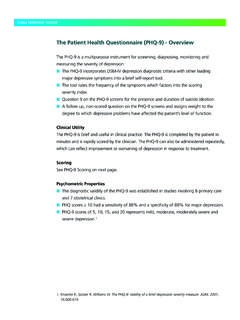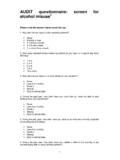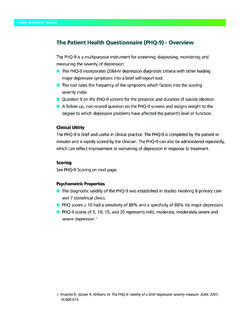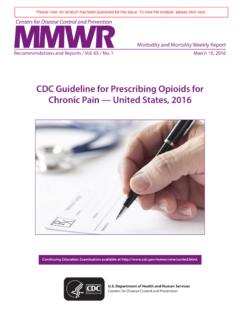Transcription of Interagency Guideline on Opioid Dosing for Chronic Non ...
1 Interagency Guideline on Opioid Dosing for Chronic Non-cancer Pain: An educational aid to improve care and safety with Opioid therapy 2010 Update 1 What is New in this Revised Guideline New data, including scientific evidence to support the 120mg MED Dosing threshold Tools for calculating dosages of opioids during treatment and when tapering Validated screening tools for assessing substance abuse, mental health, and addiction Validated two-item scale for tracking function and pain Urine drug testing guidance and algorithm Information on access to mentoring and consultations (including reimbursement options) New patient education materials and resources Guidance on coordinating with emergency departments to reduce Opioid abuse New clinical tools and resources to help streamline clinical care You can find this Guideline and related tools at the Washington State Agency Medical Directors site at Table of Contents Introduction.
2 1 2010 Update .. 1 How this Guideline is organized .. 2 Part I. guidelines for initiating, transitioning, and maintaining oral opioids for Chronic non-cancer pain .. 3 Dosing threshold for pain consultation .. 3 BEFORE you decide to prescribe opioids for Chronic pain .. 4 AFTER you decide with the patient to prescribe Chronic Opioid therapy .. 5 Principles for safely prescribing Chronic Opioid therapy .. 5 Screening and monitoring your patient .. 6 Opioid Risk Tool (ORT) .. 6 CAGE-AID .. 6 PHQ-9 .. 6 Tools for assessing function and pain .. 6 Assessing effects of Chronic Opioid therapy .. 7 Urine drug testing (UDT) .. 8 Methods of testing .. 8 Drugs or drug classes to test .. 9 Interpreting 9 Specialty consultation .. 9 Unrecognized diagnoses.
3 9 Psychological and addiction issues .. 9 Opioid management .. 10 Access to specialists and mentors .. 10 Tapering or discontinuing opioids .. 10 Recognizing and managing behavioral issues during Opioid tapering .. 11 Part II: guidelines for optimizing treatment when Opioid doses are greater than 120mg MED/day .. 12 Assessing effects of Opioid doses greater than 120mg MED/day .. 12 How to discontinue opioids or reduce and reassess at lower doses .. 12 Referrals to pain centers .. 12 Recognizing aberrant behaviors during Opioid therapy .. 12 Reasons to discontinue opioids or refer for addiction management .. 12 Referrals for addiction management .. 13 Appendices .. 15 Appendix A: Opioid dose calculations .. 16 Appendix B: Screening Tools.
4 18 Appendix C: Tools for Assessing Function and pain .. 30 Appendix D: Urine Drug Testing for Monitoring Opioid Therapy .. 31 Appendix E: Obtaining Consultative Assistance for WA Public Payers Only .. 39 Appendix F: Patient Education Resources .. 41 Appendix G: Sample Doctor-Patient Agreements for Chronic Opioid Use .. 43 Appendix H: Additional Resources to Streamline Clinical Care .. 46 Appendix I: Emergency department guidelines help coordinate care with primary care providers .. 47 References .. 48 Acknowledgements .. 55 Figures and Tables Figure 1. Morphine Equivalent Dose Calculation .. 4 Figure 2. Graded Chronic Pain Scale .. 7 Table 1. Guidance For Seeking Consultative Asistance .. 4 Table 2. Recommended frequency of UDT.
5 8 Table 3. Red flag results .. 9 Table 4. Dosing Threshold for Selected Opioids .. 15 Table 5. MED for Selected Opioids .. 16 Introduction This Guideline was originally published in March 2007 as an educational pilot. Sponsored by the Washington State Agency Medical Directors Group (AMDG)1, the original Guideline and this updated version were developed in collaboration with actively practicing providers with extensive experience in the evaluation and treatment of patients with Chronic pain. It is intended as a resource for primary care providers treating patients with Chronic noncancer pain. It does not apply to the treatment of acute pain, cancer pain, or end-of-life (hospice) care. Providers prescribing opioids know there is a delicate balance between the undertreatment and overtreatment of Chronic non-cancer pain.
6 This Guideline provides information on the scope of the challenge, recommendations for prudent prescribing and monitoring, advice on how to get consultative assistance, and resources for educating patients. 2010 Update In 2009, the AMDG surveyed medical providers in Washington State to assess the acceptability and usefulness of the Guideline and to identify ways to improve it (available at ). Results of the survey support the continued use of this Guideline with the addition of clinical tools and improved information for accessing specialty consultations. Recent studies indicate a dramatic increase in accidental deaths associated with the use of prescription opioids and an increasing average daily morphine equivalent dose (MED) of the most potent opioids since 19991-3.
7 Between 1999 2006, people aged 35 54 years had higher poisoning death rates involving Opioid analgesics than those in any other age group4. In response to the increasing morbidity and mortality associated with the increasing use of opioids, the Centers for Disease Control and Prevention5 has 1 The AMDG consists of the medical directors from these WA State Agencies: Corrections, Social and Health Services (Medicaid), Labor and Industries, and the Health Care Authority released several recommendations for how health care providers can help. The recommendations include: Interagency Guideline on Opioid Dosing for Chronic Non-cancer Pain (CNCP) Use Opioid medications for acute or Chronic pain only after determining that alternative therapies do not deliver adequate pain relief.
8 The lowest effective dose of opioids should be used. In addition to behavioral screening and use of patient agreements, consider random, periodic, targeted urine testing for opioids and other drugs for any patient less than 65 years old with noncancer pain who has been treated with opioids for more than six weeks. If a patient s dosage has increased to 120 mg MED per day or more without substantial improvement in function and pain, seek a consult from a pain specialist. Do not prescribe long-acting or controlled-release opioids ( , OxyContin , fentanyl patches, and methadone) for acute pain. The full report can be found at . Data collected in Washington state show: During 2004 2007, 1,668 WA residents had confirmed unintentional poisoning deaths due to prescription Opioid related overdoses6.
9 Nearly half of these deaths were in the Medicaid population. Unintentional Opioid -related overdose deaths increased 17-fold during 1995 2008. Hospitalizations for Opioid -related overdoses increased 7-fold during 1995 2007. Addiction treatment admissions, where prescription opioids were the primary drug of abuse, increased from to between 2000 and 2009. Prescription Opioid -related overdose deaths now exceed non-prescription Opioid -related overdose deaths7. The death rate from unintentional poisoning exceeded the death rate from motor vehicle crashes in 2006, and the gap continues to widen8. 1 Interagency Guideline on Opioid Dosing for Chronic Non-cancer Pain (CNCP) 2 The risks of Opioid use are not exclusive to the adult population.
10 According to the Healthy Youth Survey 2008 (available at ), Washington teens are using prescription Opioid pain medicine to get high. This includes: 4% of 8th graders 10 % of 10th graders (21% of these youth obtained their prescriptions from a dentist or physician) 12% of 12th graders How this Guideline is organized The purpose of Part I of the Dosing Guideline is to assist primary care providers in prescribing opioids for adults in a safe and effective manner. The purpose of Part II is to assist primary care providers in treating patients whose morphine equivalent dose (MED) already exceeds 120mg/day. Interagency Guideline on Opioid Dosing for Chronic Non-cancer Pain (CNCP) 3 Part I. guidelines for initiating, transitioning, and maintaining oral opioids for Chronic non-cancer pain Part I of the Dosing Guideline will assist primary care providers in prescribing opioids for adults in a safe and effective manner when: Instituting or transitioning Opioid therapy from acute to Chronic non-cancer pain; Assessing and monitoring Opioid therapy for Chronic non-cancer pain; and Tapering or discontinuing opioids if an Opioid trial fails to yield improvements in function and pain.




